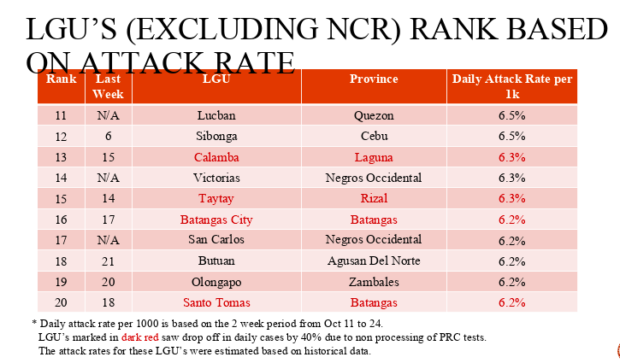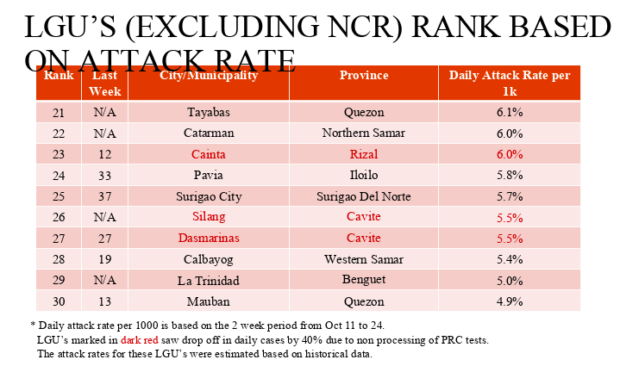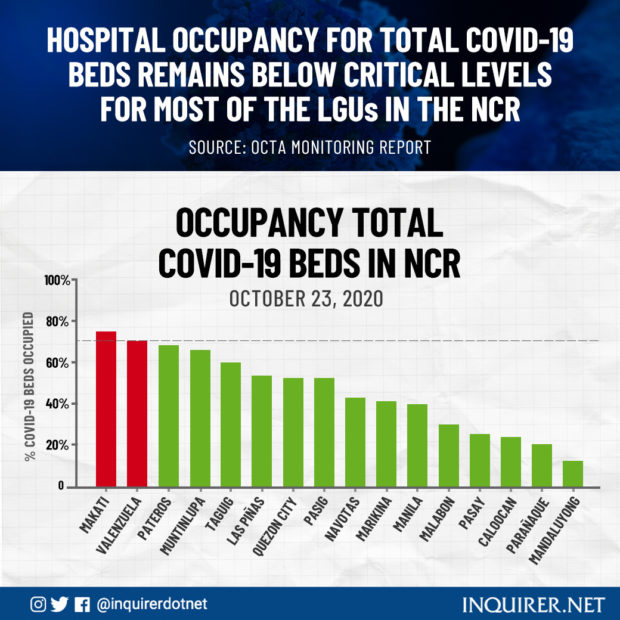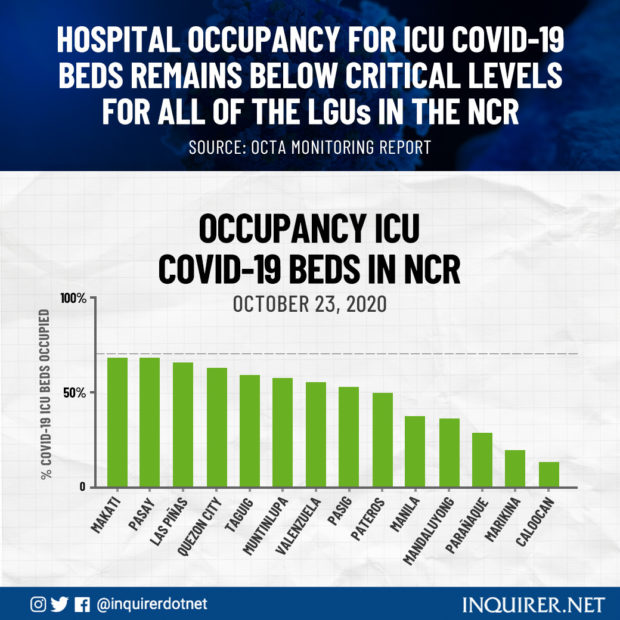18 LGUs classified as COVID-19 high-risk areas — OCTA Research

FILE PHOTO: An undated scanning electron microscope image shows SARS-CoV-2 (yellow), also known as novel coronavirus, the virus that causes COVID-19, isolated from a patient in the U.S., emerging from the surface of cells (blue/pink) cultured in the lab. NIAID-RML/Handout via REUTERS. THIS IMAGE HAS BEEN SUPPLIED BY A THIRD PARTY. MANDATORY CREDIT
MANILA, Philippines — Eighteen local government units (LGUs) in the country have been classified as “high-risk” areas due to high daily case load, attack rate, or high hospitalization occupancy, the OCTA Research, a group of experts monitoring the COVID-19 situation in the country, disclosed.
Based on the monitoring report of OCTA Research dated October 26 and released to the media on Tuesday, the following local government units were marked as high-risk or areas of concern for COVID-19:
Metro Manila
– Pasay
– Makati
– Pasig
– Mandaluyong
Rest of Luzon
– Baguio City, Benguet
– Itogon, Benguet
– Calamba, Laguna
– Angono, Rizal
– Cainta, Rizal
– Taytay, Rizal
– Lucena, Quezon
– Ilagan, Isabela
– Batangas City, Batangas
– General Trias, Cavite
Visayas
– Iloilo City, Iloilo
– San Carlos City, Negros Occidental
Mindanao
– Davao City, Davao Del Sur
– Butuan City, Agusan Del Norte
“We are concerned that these LGUs may experience high hospital burden in the coming weeks that may stress their healthcare systems and overwhelm their medical frontliners,” the OCTA Research said.
The group urged LGUs especially in high-risk areas to further intensify efforts at testing, tracing, and isolation of people to reverse the increase of coronavirus transmission at the community level.
Moreover, the group said more aggressive and effective localized lockdowns with stricter border controls is urgently needed to suppress further viral transmissions in identified high-risk areas.
“To this end, we reiterate the need for the national and the local governments to strictly monitor and enforce compliance with minimum health standards such as physical distancing, the wearing of face masks and face shields and proper hygiene to reverse the increase in transmissions at the community level,” it added.
Attack rate
In Metro Manila, Pateros topped the list of LGUs with the highest attack rate from October 11 to 24, followed by Pasay, San Juan, Makati, and Pasig.
OCTA Research explained that in the analysis of hotspots, it uses as the basis the attack rate per 1,000 population for the most recent two-week period.
“The attack rate is just the number of new cases per day relative to population. For example, a daily attack rate of 5 percent per 1000 means that there are five new cases per 100,000 of population. A higher attack rate means more people are getting infected,” it said.
In the group’s study, a province or an LGU with a daily attack rate of 1.0 percent per 1,000 is classified as low-risk.
Below is the ranking of LGUs in Metro Manila based on attack rate, according to the research team:
Below is the ranking of LGUs outside Metro Manila based on attack rate:
Hospital occupancy
According to OCTA Research, hospital occupancy for total COVID-19 beds remains below critical levels for most LGUs in Metro Manila.
Meanwhile, hospital occupancy for COVID-19 beds in intensive care units remains below critical levels for all of the LGUs in NCR.
JPV
For more news about the novel coronavirus click here.
What you need to know about Coronavirus.
For more information on COVID-19, call the DOH Hotline: (02) 86517800 local 1149/1150.
The Inquirer Foundation supports our healthcare frontliners and is still accepting cash donations to be deposited at Banco de Oro (BDO) current account #007960018860 or donate through PayMaya using this link.





